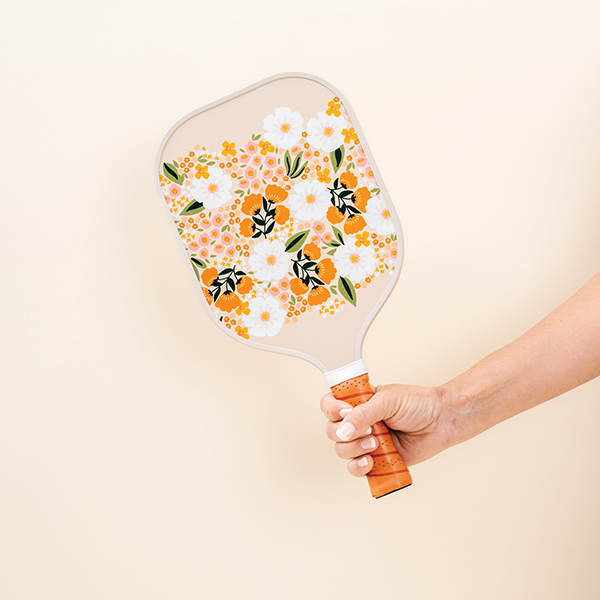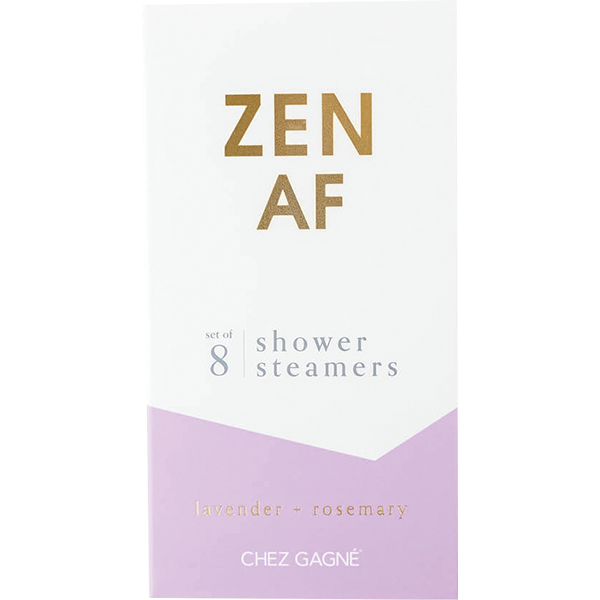Tables Set for Casual Chic
Casual Entertaining
The fine china and crystal stemware of formal dinner parties has been relegated to a display shelf in the family’s china cabinet. Taking its place on tabletops across the country are items that have a luxurious feel, but are a bit more casual.
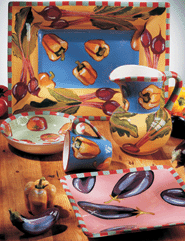 “Consumers want to entertain centering on their lifestyle rather than the formality of yesterday,” says Heather Tirino, marketing coordinator for Zrike Co., a tableware designer and distributor in Oakland, NJ. “People are not sitting around a formal table anymore. The focus is on the people who are gathered together rather than the formality.”
“Consumers want to entertain centering on their lifestyle rather than the formality of yesterday,” says Heather Tirino, marketing coordinator for Zrike Co., a tableware designer and distributor in Oakland, NJ. “People are not sitting around a formal table anymore. The focus is on the people who are gathered together rather than the formality.”
Julia Knight, owner and chief executive officer of Julia Knight America, a tableware and home accessories design company in Orono, MN, agrees.
“My entertaining style has changed over the years,” Knight says. “I used to have elaborate dinner parties with course after course being served. The way I entertain now is more like, ‘Why don’t you come to my wonderful home, you bring some wonderful food and I’ll put it on my wonderful dishes.'”
The shift in trends
This idea is nothing new to Pam Danziger, president of Unity Marketing, a consumer-research firm in Stevens, PA. Danziger is the author of several books on consumer behavior, including Shopping: Why We Love It and How Retailers Can Create the Ultimate Customer Experience. In a recent study, Unity Marketing surveyed 1,300 tabletop consumers and put together the Tabletop Market Report, 2006. The report found that the tabletop market has been on a slow growth trajectory for the past five years. U.S. sales reached $9 billion in 2005, rising 3.1 percent from the previous year. The report also gauged consumer preferences and found that nearly 80 percent agreed with the statement: “My lifestyle is more casual, so I prefer to set my table with more casual, less formal tableware.” In addition, two-thirds agreed with: “When I entertain, I prefer to set my table with upscale but casual dinnerware that is easy to care for and that I can put in the dishwasher.”
As part of the report, Danziger determined that four different personality types make up the tabletop market. Neo-Conservative Conrad/Connie is the largest consumer segment, comprising 34 percent of the market, carrying an equal representation of men and women. “This consumer is rather traditional about their use and preferences for tabletop,” Danziger says. “They embrace ‘new luxury,’ not [the old school] formality.” Casual Carol makes up the second-largest segment, representing 25 percent of the total market. She wants nothing to do with formal tabletop because it does not fit her lifestyle. Formerly Formal Frances, representing 22 percent of tabletop consumers, is leaving her formal dinnerware in the china cabinet. She now sets her table with the preferred casual luxury styles. Frances looks for ease of use, convenience and comfort in her tabletop items. Helena, the Hostess with the Mostest, is the smallest segment, representing 19 percent. She lives a casual lifestyle, but leans toward a more formal table presentation. Helena’s primary use of formal dinnerware is for entertaining purposes.
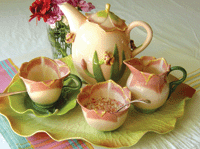 Danziger concludes that consumers want tableware they can dress up or dress down, depending on the occasion. “People want tabletop items that are better than everyday,” she says, “but more casual than formal dinnerware.” Tony Damiano, owner of Mango Jam in Ridgewood, NJ, which features an eclectic mix of tableware, indicates that the emphasis is on the casual. “The most important thing is that items be microwaveable and dishwasher safe,” Damiano says. “If customers are looking at hand-painted items and they are not dishwasher safe, they won’t buy them.”
Danziger concludes that consumers want tableware they can dress up or dress down, depending on the occasion. “People want tabletop items that are better than everyday,” she says, “but more casual than formal dinnerware.” Tony Damiano, owner of Mango Jam in Ridgewood, NJ, which features an eclectic mix of tableware, indicates that the emphasis is on the casual. “The most important thing is that items be microwaveable and dishwasher safe,” Damiano says. “If customers are looking at hand-painted items and they are not dishwasher safe, they won’t buy them.”
It is precisely these kinds of functional items that tableware maker and designer Kate Carlyle of Mustardseed and Moonshine makes. Carlyle’s artistic pieces handmade in South Africa, where she is based, have received high praise in the “O List,” a list of product recommendations by Oprah Winfrey in her monthly magazine. Each piece in the Mustardseed and Moonshine collection is modeled after real flowers and handmade and hand-painted. Even though they have high artistic appeal, Carlyle says they wouldn’t be as popular as they are now, if they weren’t functional art that could be thrown in the microwave and dishwasher. “I was always fascinated by flowers but wanted to create tableware that would last longer than real flowers. The tableware is functional it’s an added bonus that you eat out of a flower,” Carlyle says.
The new wave of tabletop settings has been labeled by various authorities in the industry as “sophisticated luxury,” “relaxed sophistication” and “casual chic.” Danziger calls it “casual luxury.”
“The concept of ‘casual luxury’ sounds like a non-sequitur, but there are precedents in other product categories,” Danziger says. “Take watches, for instance, where the everyday is Timex, the luxury is Rolex and the ‘casual luxury’ is Swatch or Fossil.”
No matter what it is called, the trend is here to stay, a fact that Katrina Stevenson, a marketing coordinator for DEMDACO, a Stilwell, KS-based wholesaler of tableware and other gift accessories, can attest to. “It’s all about everyday informal casual appeal,” she says, adding that the company’s stoneware lines appeal precisely because they are elegant without being overly fussy. Amy Stavis, editor and publisher of Tableware Today, a trade magazine for the tabletop industry, warns, “Tabletop manufacturers who have not shifted in a timely manner will eventually be out of business.”
Getting on board
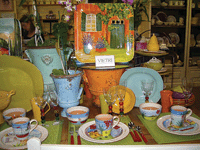 Companies are heeding the signs. “Throughout the home goods business over the last 10 to 15 years, the trend has been to a more casual lifestyle,” says Perry Reynolds, vice president of marketing and trade development for the International Housewares Association, a full-service Chicago-based trade association dedicated to promoting the sales and marketing of housewares. “More recently, over the last five to 10 years, it seems to have an impact on tabletop. This [casual lifestyle] trend is completely consumer-driven,” Reynolds says. “The industry has responded to the trend once it was recognized. Consumers now have a wider range of products from which to choose.”
Companies are heeding the signs. “Throughout the home goods business over the last 10 to 15 years, the trend has been to a more casual lifestyle,” says Perry Reynolds, vice president of marketing and trade development for the International Housewares Association, a full-service Chicago-based trade association dedicated to promoting the sales and marketing of housewares. “More recently, over the last five to 10 years, it seems to have an impact on tabletop. This [casual lifestyle] trend is completely consumer-driven,” Reynolds says. “The industry has responded to the trend once it was recognized. Consumers now have a wider range of products from which to choose.”
Laura Walas, a Chicago store manager for Tabula Tua, which sells an eclectic mix of handmade ceramic and serving pieces from artisans all over the world, says that fine china is no longer “in.”
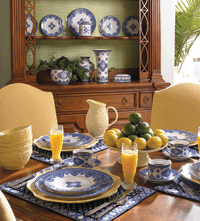 “The casual luxury trend is what it is all about,” Walas says. “The reason we started this store was because we wanted dinnerware to be anything but china.”
“The casual luxury trend is what it is all about,” Walas says. “The reason we started this store was because we wanted dinnerware to be anything but china.”
Designers and manufacturers are also making changes. “I discontinued my high-end china collection in January 2006 so I can embrace the luxury, high-end setting,” says Michael Weems, the designer and owner of The Michael Weems Collection of hand-etched and hand-carved crystal, glassware and dinnerware. “I will come out with new, elegant etched glasses, plates and bowls in January 2007.” Some retailers were on the cutting edge before the larger trend started. “We have been here six years,” says Damiano, of Mango Jam. “We did not have to switch the stock from formal items, because we started with the casual luxury.”
“We are in an interesting position,” says Cara Fratto, marketing manager for Vietri, an importer of Italian handcrafted tableware and home decor products in Hillsborough, NC. “We have seen a big flow of information about the trend change, but we have been doing casual luxury all along.” On the other hand, Susan and Craig Hamilton, who co-own Pineapple Post in Jacksonville Beach, FL, had to make some changes when they purchased their store five years ago. Pineapple Post offers dinnerware as well stationery, candles, greeting cards and other items. “The store before we bought it did have a high-end china line, Herend Porcelain, and collectibles,” Hamilton says. “But brides were not registering for that anymore. The company required that we have $20,000 to $25,000 of stock that did not move. So, we made the decision to get out of it and sold off the existing stock at a discount.”
Here comes the casual
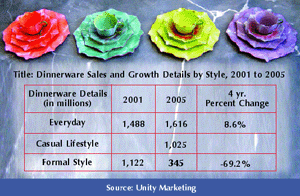 Bridal registries have also had an impact on the change to casual chic. “What I hear is that people inherit china, and they want to keep that,” says Walas, of Tabula Tua. “So people now are doing both formal and casual. Some still do register for china; others want a more casual luxury. They want something beautiful to use on a daily basis with their own family and on special occasions.” Linda Tabas, owner of The Pink Daisy in Langhorne, PA, agrees. “Used to be when our grandparents and older generations came over from the old country, they didn’t have anything, so formal china was big. Now brides inherit a lot of china from the grandparents or parents, so they don’t need as much formal pieces anymore,” Tabas says.
Bridal registries have also had an impact on the change to casual chic. “What I hear is that people inherit china, and they want to keep that,” says Walas, of Tabula Tua. “So people now are doing both formal and casual. Some still do register for china; others want a more casual luxury. They want something beautiful to use on a daily basis with their own family and on special occasions.” Linda Tabas, owner of The Pink Daisy in Langhorne, PA, agrees. “Used to be when our grandparents and older generations came over from the old country, they didn’t have anything, so formal china was big. Now brides inherit a lot of china from the grandparents or parents, so they don’t need as much formal pieces anymore,” Tabas says.
Jean Schroder, marketing specialist for Andrea by Sadek, a tableware and home accessories designer and distributor in New Rochelle, NY, has seen similar consumer actions. “The stores we supply to, do have bridal registries,” Schroder says. “Our retailers are seeing a need to have both a formal and a casual registry.” Zaven Kassabina, president of Intrada, a Los Angeles-based importer of handcrafted dinnerware and other products by Italian artisans, also sees the trend. “Customers are asking for casual luxury items more,” he says. “It is very hot right now.” Tirino, of Zrike, agrees. “Although we are not geared toward the bridal market, I have noticed the trend is not to register for bone and porcelain china anymore,” she says. “Things are more casual now. People go with earthenware and ceramics in lieu of fine china. It is reflecting their lifestyle.”
Dinnerware sets are changing
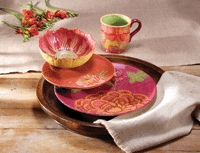 There may be no better example of changing lifestyles than the desire of consumers to have mugs rather than cups and saucers in place settings. “People want mugs now,” Hamilton says. “Tableware manufacturer Juliska offers mugs and a cup and saucer. Vietri had a mug, but people were interested in a chunkier mug. Now they keep both versions.” Weems, of The Michael Weems Collection, rejects the cup-and-saucer idea. “I am a big guy with long fingers and many times the cups are too dainty,” he says. “I feel like I am at a kids’ tea party or having tea with the queen. It is much easier with something comfortable in my hand.” The shift away from cups and saucers is a sign of the times, according to Mango Jam’s Damiano. “That is one aspect that has changed dramatically in the last 10 years,” Damiano says. “Everyone uses mugs. We are all into the Starbucks thing with the oversized mugs.”
There may be no better example of changing lifestyles than the desire of consumers to have mugs rather than cups and saucers in place settings. “People want mugs now,” Hamilton says. “Tableware manufacturer Juliska offers mugs and a cup and saucer. Vietri had a mug, but people were interested in a chunkier mug. Now they keep both versions.” Weems, of The Michael Weems Collection, rejects the cup-and-saucer idea. “I am a big guy with long fingers and many times the cups are too dainty,” he says. “I feel like I am at a kids’ tea party or having tea with the queen. It is much easier with something comfortable in my hand.” The shift away from cups and saucers is a sign of the times, according to Mango Jam’s Damiano. “That is one aspect that has changed dramatically in the last 10 years,” Damiano says. “Everyone uses mugs. We are all into the Starbucks thing with the oversized mugs.”
The “upsizing” of drinking containers and the trend toward casual chic table settings are results of other lifestyle changes, according to Reynolds, of the IHA. “From 1950 to 2000, the Census Bureau found that the average size of an American home was up 50 percent,” Reynolds says. “I suspect that many homes have another place to eat other than the formal dining room, and that area is probably used more than the dining room. “That is just one piece of the more casual trend,” Reynolds says. “Another thing that has happened is the fusion of design and innovation in all home goods. It used to be that an upgrade was a different color or a small adaptation. Now the emphasis is on design—the function and aesthetics of a piece. Tabletop is driven to different shapes and designer looks.”
It’s all about color
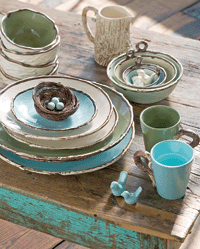 And the looks often revolve around color. “Customers are more daring today,” Damiano says. “People are branching out. It is reflected in their homes. People used to have beige and other neutral-colored walls. Now you are seeing color in the homes.” And new colors will find their way to tabletop settings, according to Leatrice Eiseman, executive director of the Pantone Color Institute and director of the Eiseman Center for Color Information and Training. At the center, based in Seattle, Eiseman teaches programs in color consulting with an emphasis on the psychology of color.
And the looks often revolve around color. “Customers are more daring today,” Damiano says. “People are branching out. It is reflected in their homes. People used to have beige and other neutral-colored walls. Now you are seeing color in the homes.” And new colors will find their way to tabletop settings, according to Leatrice Eiseman, executive director of the Pantone Color Institute and director of the Eiseman Center for Color Information and Training. At the center, based in Seattle, Eiseman teaches programs in color consulting with an emphasis on the psychology of color.
Eiseman also is the author of The Color Answer Book: From the World’s Leading Color Expert. “I don’t think there is one tabletop look that trounces all of the others,” she says. “There are so many different taste levels and comfort levels on the part of consumers, that the one-color-fits-all category doesn’t work for all consumers.” Stevenson at DEMDACO agrees. “We have color all over the place with primaries and brights and whites and the new neutrals. Since everyone has so many varied tastes, we make sure to carry tabletop in a wide range of colors so there can be something for everyone,” she says.
Mix and match
Mixing and matching colors, as well as mixing and matching merchandise, helps retailers sell more. “We try to be color-coordinated,” says Damiano. “With the tables that are showing the wares you should mix and match—in the glassware too. It is all about color. With goblets, we have assorted colors on the table.” The mixing and matching aspect of casual chic is a big seller for Pineapple Post.
“Some people just want to do accents,” Hamilton says. “Vietri mixes well with itself and other dishes. Sometimes people bring in their own dinnerware and they think it is a little boring, so they want to add to it. They add dessert/salad plates or serving dishes. One woman brought in some orange plates she had purchased at Stein Mart. We had some Vietri serving dishes with a cream-colored background and some dots. One orange dot matched her dishes, so she bought them.”
Mixing and matching also works for Tabula Tua. “We sell by the piece, and the whole idea is to mix and match things using shapes and sizes relevant to the serving and cooking that you do,” Walas says. “In our store, in the cabinets on the walls, we show the dinnerware by style and color. Then we have tables throughout the store in settings showing the versatility. You can buy from one line and mix it with another line.”
Outdoor movement
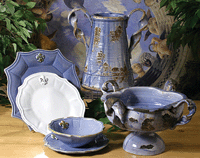 “The casual elegance influence is moving to the outdoors as well,” Reynolds says. “Virtually every retailer I saw who was involved with home products in spring of 2006, with advertisements for outdoor furniture and other outdoor products, always accessorized with hard tabletop items. That follows a trend of the desire to create a space to include the outside of the home. The retailers are driving the fusion of outdoor living and tabletop. Retailers are putting out more products that represent this trend,” he says. Advertisements were followed by many in-store displays that featured casual chic tabletop items in outdoor settings, according to Reynolds. “A consumer is likely to bring that casual elegance outdoors and bypass the more disposable products,” he says.
“The casual elegance influence is moving to the outdoors as well,” Reynolds says. “Virtually every retailer I saw who was involved with home products in spring of 2006, with advertisements for outdoor furniture and other outdoor products, always accessorized with hard tabletop items. That follows a trend of the desire to create a space to include the outside of the home. The retailers are driving the fusion of outdoor living and tabletop. Retailers are putting out more products that represent this trend,” he says. Advertisements were followed by many in-store displays that featured casual chic tabletop items in outdoor settings, according to Reynolds. “A consumer is likely to bring that casual elegance outdoors and bypass the more disposable products,” he says.
Knight agrees. “Many people have amazing outdoor kitchens, so you bring the entertaining luxury outdoors with something more appealing, and not just plastic plates that you get at a department store,” she says.
For retailers, the message is that consumers are looking for something elegant, not overly formal—something that “food will look beautiful in.” From all indications, if retailers are not catering to the casual chic tabletop market, they could find themselves with the luxury of too much time on their hands.



















